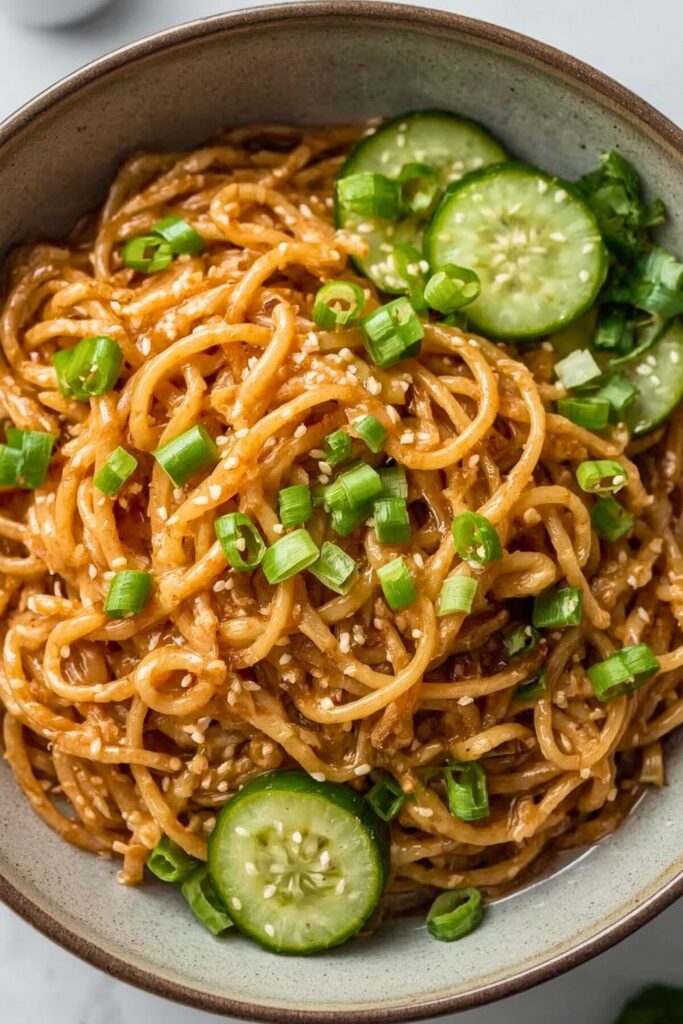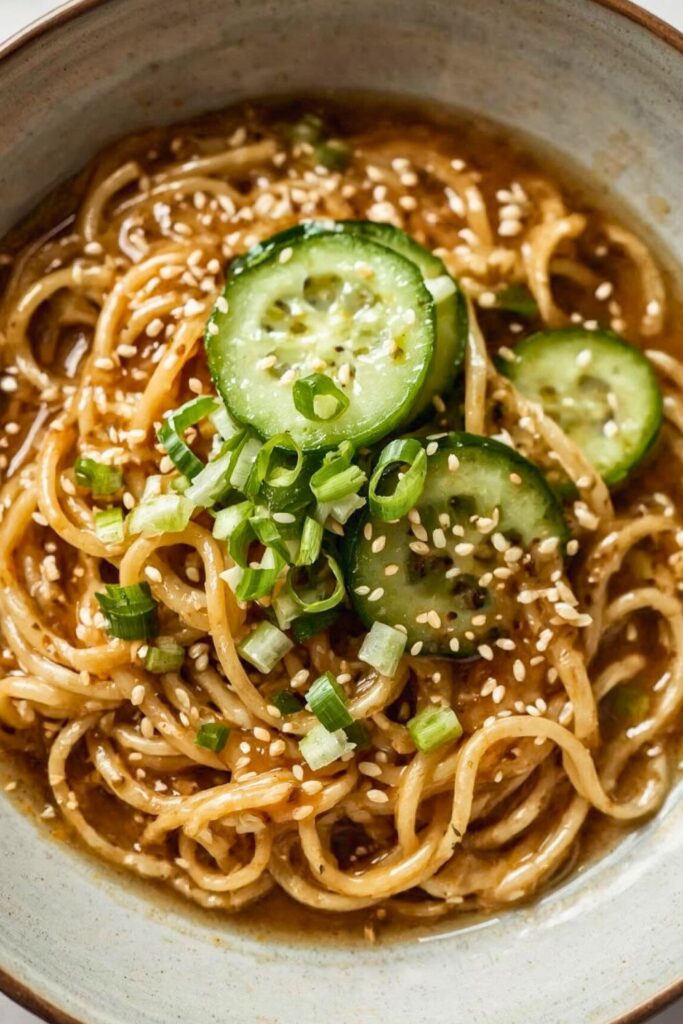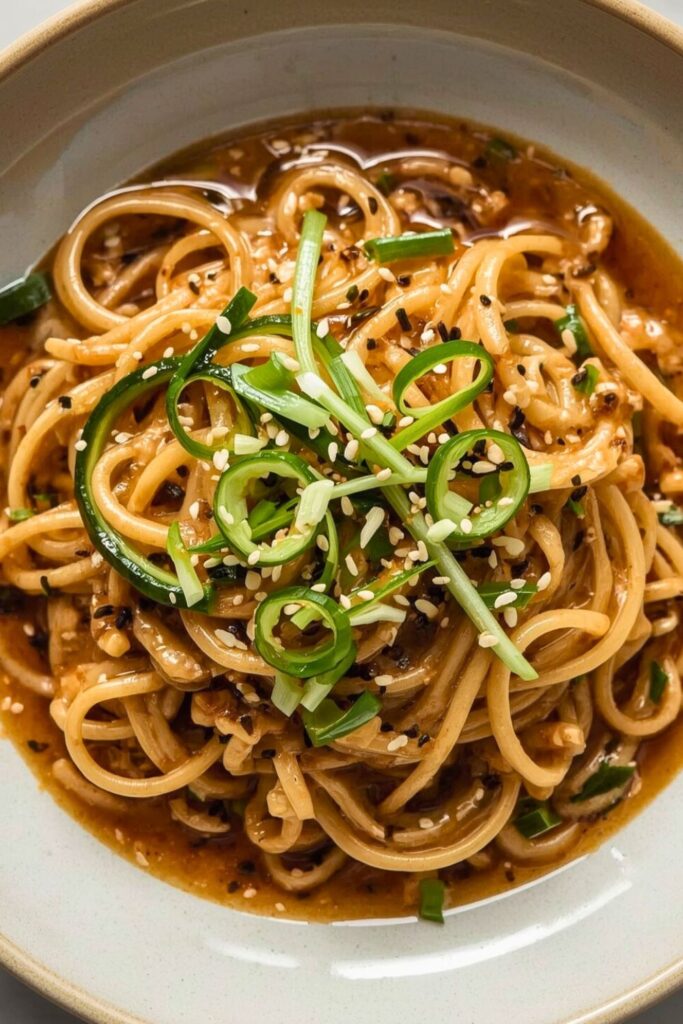Picture this: It’s sweltering outside, your kitchen feels like a sauna, and the thought of turning on the stove makes you wanna crawl into the freezer. But you’re craving something satisfying, something that’ll hit all those umami notes without making you break another sweat. Enter cold sesame noodles, the dish that’s about to become your summer salvation and quite possibly your new obsession.
I discovered this game changer during a particularly brutal July in my tiny Brooklyn apartment. No AC, ancient windows that barely opened, and a serious case of hangry desperation. My neighbor knocked on my door with a container of these silky, nutty, absolutely addictive cold sesame noodles that she’d whipped up without heating her place above comfortable. One bite and I knew my hot weather cooking had been revolutionized forever.
Cold sesame noodles aren’t just another pasta salad trying too hard to be interesting. They’re the perfect marriage of Chinese technique and that universal craving for something cool, creamy, and deeply satisfying. The magic happens in that glossy sesame sauce that clings to every strand of noodle like it was meant to be there. And here’s the kicker, they actually taste better after sitting in the fridge for a few hours, making them the ultimate make ahead dish that gets more delicious with time.
Why Cold Sesame Noodles Deserve Kitchen Stardom

Let me tell you why this dish is pure genius. First off, it’s basically impossible to mess up once you understand the basics. The sauce comes together in minutes, and you’re not juggling multiple pans or worrying about perfect timing. It’s that rare recipe that’s equally at home at a fancy dinner party or packed for lunch on a random Tuesday.
The beauty lies in the simplicity. You’ve got your noodles (and we’ll talk about which ones work best), your silky sesame sauce, and whatever fresh additions make your heart sing. Cucumber for crunch, scallions for bite, maybe some shredded chicken if you’re feeling protein hungry. But even naked, these cold sesame noodles are pure magic.
There’s also something deeply satisfying about the texture contrast. Those slightly chewy noodles against the smooth, nutty sauce, punctuated by whatever crispy vegetables you decide to throw in. It’s like your mouth is getting a little massage with every bite. And that sesame flavor? It’s rich without being heavy, complex without being fussy.
Ingredients That Work Magic
Let’s talk about what you actually need for this masterpiece. I’m gonna list these in the order you’ll use them, because that’s how real cooking works:
For the noodles:
- 1 pound fresh Chinese wheat noodles (or dried lo mein)
- 2 tablespoons sesame oil
- Salt for pasta water
For the killer sesame sauce:
- 6 tablespoons tahini or Chinese sesame paste
- 3 tablespoons soy sauce
- 2 tablespoons rice vinegar
- 1 tablespoon sugar
- 1-2 teaspoons chili oil (optional but recommended)
- 2 cloves garlic, minced
- 1 teaspoon fresh ginger, grated
- 2-3 tablespoons warm water
The fresh finale:
- 1 cucumber, julienned
- 4 scallions, sliced thin
- 2 tablespoons sesame seeds
- Fresh cilantro (if you’re team cilantro)
Now, here’s where I become your ingredient fairy godmother. Can’t find Chinese sesame paste? Tahini works beautifully, though it’s slightly less intense. No fresh noodles at your market? Dried lo mein or even spaghetti will do the job, just cook ’em al dente.
Living somewhere without decent chili oil? Make your own by heating neutral oil with red pepper flakes and letting it cool. Or skip it entirely if heat isn’t your thing. This recipe is forgiving like that.
Here’s a pro tip about tahini: give that jar a good stir before using it. The oil separates, and you want it all mixed up for the smoothest sauce. Also, taste your tahini first. Some brands are nuttier, some are more bitter. Knowing what you’re working with helps you adjust the other flavors.
Step by Step Magic

Getting those noodles perfect:
Start by bringing a large pot of salted water to a rolling boil. I mean really salted, it should taste like the sea. Fresh noodles need just 2-3 minutes, while dried varieties might need 4-6. You want them tender but still with a slight chew. Nobody likes mushy noodles, especially when they’re gonna sit in sauce.
Drain ’em immediately and rinse with cold water until they’re completely cool. This stops the cooking process dead in its tracks. Toss them with that sesame oil to prevent sticking, trust me on this one. I’ve rescued too many sad, clumped noodle disasters to skip this step.
Creating sauce magic:
While your noodles are cooling, whisk together the tahini, soy sauce, rice vinegar, and sugar in a bowl. It might look a little thick at first, that’s where the warm water comes in. Add it gradually until you get a consistency that’s creamy but not gloppy. Think Caesar dressing, not peanut butter.
Stir in that minced garlic and grated ginger. Fresh ginger makes all the difference here, the stuff from a jar just doesn’t have the same zing. If you’re feeling spicy, this is when you swirl in that chili oil.
Here’s something most cold sesame noodles recipes won’t tell you: taste and adjust as you go. Some tahinis are saltier, some rice vinegars are more acidic. Your tongue knows what it wants better than any recipe ever could.
Bringing it all together:
Pour that gorgeous sauce over your cooled noodles and toss like your life depends on it. Every single strand should be coated. This is where having slightly warm sauce really helps, it distributes more evenly and creates that glossy finish you’re after.
Add your julienned cucumber and most of those scallions, saving some for garnish. The cucumber adds this amazing fresh crunch that cuts through the richness beautifully. If you’re adding protein like shredded chicken or tofu, now’s the time.
The Secret Behind Silky Perfection
Let me geek out for a second about why this combination works so well. Tahini is basically ground sesame seeds suspended in their own oil, which means it’s naturally emulsifying. When you whisk it with the acidic rice vinegar and salty soy sauce, you’re creating a stable emulsion that clings to noodles like nobody’s business.
The sugar isn’t just for sweetness, it’s balancing the bitterness that tahini can sometimes have and enhancing all those other flavors. It’s the same principle behind adding a pinch of sugar to tomato sauce. Sometimes you need sweet to make savory sing.
That sesame oil you tossed the noodles with? It’s not just anti stick insurance. It’s creating another layer of sesame flavor and helping the sauce adhere better. Plus, sesame oil has this amazing property where it gets more fragrant as it sits, which is why these cold sesame noodles taste even better the next day.
Room temperature is key here too. Cold noodles don’t absorb flavors as well, and hot noodles would make your sauce break. That lukewarm sweet spot lets everything meld together perfectly.
Making The Recipe Restaurant Beautiful
Want your cold sesame noodles to look like they came from your favorite takeout spot? Here’s how the pros do it: arrange them in a shallow bowl rather than a deep one. This shows off all those beautiful colors and textures instead of hiding them.
Garnish with purpose. Those reserved scallions go on top for color and freshness. Sprinkle sesame seeds like you mean it, they add visual interest and a little extra crunch. A few cilantro leaves scattered around doesn’t hurt either, if you’re into that.
For photos (because let’s be real, you’re gonna want to share this), natural light is your friend. The glossy sauce catches light beautifully, and those green scallions pop against the tan noodles.
What pairs beautifully:
These cold sesame noodles play well with others. They’re fantastic alongside grilled chicken or fish, but they also stand alone as a light dinner. I love them with steamed dumplings for a proper feast, or as part of a spread with other cold dishes on blazing hot days.
Beverage wise? A crisp white wine cuts through the richness beautifully. Riesling or Sauvignon Blanc work great. Beer lovers should go for something light and refreshing, a wheat beer or even a good lager.
Your New Summer Obsession: Cold Sesame Bowl

Here’s what makes cold sesame noodles special: they’re that rare dish that satisfies on every level. Rich enough to feel indulgent, fresh enough for the hottest days, and complex enough to keep you coming back for more. They’re proof that the best comfort food doesn’t always have to be hot.
Once you master this basic cold sesame noodles version, the world opens up. Try it with shredded cabbage instead of cucumber. Add some edamame for extra protein. Throw in some matchstick carrots for sweetness and color. The formula stays the same, but the variations are endless.
The real secret? Make a double batch. These cold sesame noodles are even better the second day, and trust me, you’re gonna want leftovers. They keep beautifully in the fridge for up to three days, though they rarely last that long around my house.
Frequently Asked Questions
Can I make cold sesame noodles ahead of time?
Absolutely, and you should! These cold sesame noodles are actually better after they’ve had time to sit and let all those flavors meld together. Make them up to a day ahead, but add the cucumber and garnishes right before serving so they stay crisp. Store covered in the fridge, and give them a good toss before serving since the sauce might settle a bit.
What if I can’t find Chinese sesame paste?
Regular tahini works perfectly as a substitute in cold sesame noodles. It’s got a slightly different flavor, a bit nuttier and less intense, but it creates the same silky texture. Start with the same amount the recipe calls for, then taste and adjust. You might want to add an extra drizzle of sesame oil to boost that sesame flavor.
My sauce turned out too thick. How do I fix it?
This happens more often than you’d think, especially if your tahini was particularly thick to begin with. Just whisk in warm water, one tablespoon at a time, until you reach that perfect creamy consistency. The sauce should coat the noodles without being gloppy. Remember, you can always add more liquid, but you can’t take it away.
Can I use different types of noodles for cold sesame noodles?
Definitely! Fresh Chinese wheat noodles are ideal, but dried lo mein, udon, or even spaghetti work great. The key is cooking them just until tender but still with a slight bite. Thicker noodles hold the sauce better, but honestly, I’ve made delicious cold sesame noodles versions with whatever pasta I had on hand.
How spicy is this dish with the chili oil?
The chili oil adds warmth rather than serious heat, it’s more about flavor than fire. Start with less and add more to taste. If you’re sensitive to spice, skip it entirely. The cold sesame noodles dish is absolutely delicious without any heat at all. You can always serve chili oil on the side for people to add their own.

Swiftly Captions by Tina Smith — Quick, flavorful food recipes made simple, bringing fresh inspiration to your kitchen every day






